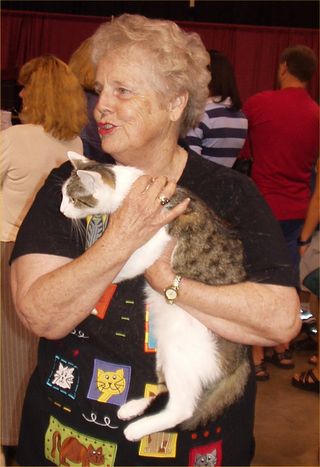You love your dog or cat. Someday your dog or cat will die. (I’m sorry, but it’s inevitable.) What if you could put aside the genetic materials to make a perfect copy of your beloved animal, a clone of your pet? Would you do it?
This is something we need to think about, as individuals and, more importantly, as a society. Cloning of pets is no longer just laboratory science. The technology is now widely available, and there is good reason to think that over the next decade, pet cloning will become much more broadly available, as the industry reaches greater levels of efficiency and achieves economies of scale, and the price comes down.

Several companies are selling this service to pet owners. Take, for example, ViaGen, “America’s most trusted animal cloning company.” Although much of ViaGen’s work appears to be in the area of livestock breeding, they also have a dedicated “ViaGen Pets” branch. “ViaGen Pets,” the company tells us, “is committed to helping dog and cat owners continue the loving embrace and experience with their animals through the delivery of healthy genetic twins that may embody many of the same personality and behavioral traits.”
ViaGen offers two main services to pet owners. (For now, they only work with dogs and cats, but who knows what the future might hold for guinea pigs, rabbits, and ferrets.) First, they offer what they call Genetic Preservation (GP), which will cost you $1600. GP involves the pet owner’s veterinarian taking a tissue biopsy from the animal and sending the sample to ViaGen. ViaGen cultures new cells from the tissue sample and the cells are then frozen and stored. If the pet owner decides, at some point in the future, that they would like to clone their animal—even if the animal has been deceased for 10, 20, 30 years—the cells can be thawed and used to create a clone. Typically a pet owner takes a sample while their animal is still living, but tissue samples can also be taken from an animal who has died, if done within the first couple of days and if the body has been kept cool.
Cloning produces an identical twin, but of a different age. The cloned dog or cat will not, of course, be the exact same animal but he or she will look very similar and will likely have a similar temperament. How exactly does it work? First, ViaGen procures a “donor dog” or “donor cat,” who will serve as the surrogate mother. When the donor female is in estrus, her eggs are sucked out (imagine a high-tech turkey baster), the DNA wiped clean, and the new DNA from the pet’s tissue sample injected into the egg. The eggs are then transferred (think turkey baster again) back into the donor animal, who will gestate the egg(s), carry them to term, and then give birth. Hugely oversimplified, but that is the basic process. ViaGen currently charges $50,000 to clone a dog and $25,000 to clone a cat. (Cats are cheaper because they are easier: their reproductive cycles are less complicated and easier to manipulate and donor cats are easier and less costly to procure).
What are some of the potential moral problems posed by the cloning of pets?
Cloning involves a lot of “mistakes” and false starts and failures. This is one of the key reasons people oppose human cloning research: it causes the destruction of numerous embryos, miscarriages, and fetal abnormalities. Maybe we don’t worry about dog or cat embryos and fetuses as much we do human embryos, but isn’t a potential life, a nascent being, of some value?
What about the health of the cloned offspring? This is hard to nail down, since we don’t have longitudinal data on the health of cloned pets and the sample size is still pretty small (unless you count cloned dogs and cats who were research subjects, not pets). There appears to be some possibility for higher rates of health problems, but the risk is pretty speculative and probably fairly low.
Who actually gestates and gives birth to the cloned animals? This may be the most serious problem with pet cloning. The cloned dogs and cats don’t simply materialize; they are “grown” in the body of a dog or cat who serves as a surrogate. ViaGen sources their donor dogs from a Class A dealer—drawing from a pool of dogs who have been purpose-bred for research. To clone a smaller dog, like a rat terrier, they would source a beagle; to clone a larger dog, like a golden retriever, they would source a hound. For any given cloning project, several dogs would be selected as donors and fertilized with cloned-DNA eggs, to increase the “success rate” (the likelihood that one of the eggs would “take”). This involves some manipulation of the donor dogs hormonal levels, again to increase the rate of success. After being impregnated (if all goes well), the donor dog would gestate the pregnancy and give birth. At this point, they would be returned (sold back?) to the Class A dealer and be available for purchase as a research subject. We are given a stark reminder that the same species of animal can inhabit very different moral habitats within the human mind. People who love their dog enough to clone her would likely shudder at the thought of this same dog being purpose-bred for use as a breeding machine.
Does cloning harm pet dogs and cats, as a whole? It is hard to answer this question, but it does seem that the creation, through artificial and expensive means, of more dogs and cats is morally offensive when so many healthy dogs and cats are languishing in shelters, needing a home.
Does cloning de-value the individual? This is a highly personal question and one that will likely be answered differently by each person. For some, the cloning of their dog or cat might be the ultimate expression of love. I, on the other hand, can’t imagine cloning my dog Maya. There will never be another Maya, and I wouldn’t want another Maya. She is unique and precious and when she dies, she’ll live in my memory. (I wouldn’t clone my dog Bella because she is . . . well. . . let’s just say that one Bella is all that I can handle in this lifetime.)
What, exactly, is ViaGen selling? They are selling a dream of happiness, the dream of never having to lose an animal who you dearly love. But of course this dream is an illusion, and may simply feed into our fear and denial of death—by pretending that our pet can be immortal.
The short animated video on the ViaGen website tells prospective clients that loving an animal doesn’t have to be a once in a lifetime experience. They can “make it twice in a lifetime,” or maybe even more. I don’t know about you, but I cherish the fact that Maya and Bella are “once in a lifetime” friends.
Is cloning pets ethical? If you could afford it, would you do it?




